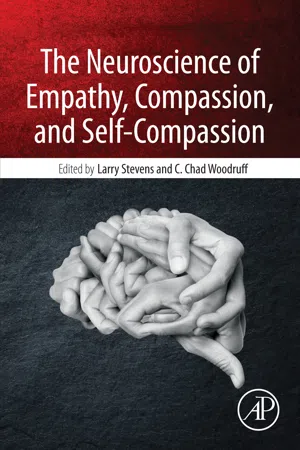
The Neuroscience of Empathy, Compassion, and Self-Compassion
- 353 pages
- English
- ePUB (mobile friendly)
- Available on iOS & Android
The Neuroscience of Empathy, Compassion, and Self-Compassion
About this book
The Neuroscience of Empathy, Compassion, and Self-Compassion provides contemporary perspectives on the three related domains of empathy, compassion and self-compassion (ECS). It informs current research, stimulates further research endeavors, and encourages continued and creative philosophical and scientific inquiry into the critical societal constructs of ECS. Examining the growing number of electrocortical (EEG Power Spectral, Coherence, Evoked Potential, etc.) studies and the sizeable body of exciting neuroendocrine research (e.g., oxytocin, dopamine, etc.) that have accumulated over decades, this reference is a unique and comprehensive approach to empathy, compassion and self-compassion.- Provides perspectives on empathy, compassion and self-compassion (ECS), including discussions of cruelty, torture, killings, homicides, suicides, terrorism and other examples of empathy/compassion erosion- Addresses autonomic nervous system (vagal) reflections of ECS- Discusses recent findings and understanding of ECS from mirror neuron research- Covers neuroendocrine manifestations of ECS and self-compassion and the neuroendocrine enhancement- Examines the neuroscience research on the enhancement of ECS- Includes directed-meditations (mindfulness, mantra, Metta, etc.) and their effects on ECS and the brain
Frequently asked questions
- Essential is ideal for learners and professionals who enjoy exploring a wide range of subjects. Access the Essential Library with 800,000+ trusted titles and best-sellers across business, personal growth, and the humanities. Includes unlimited reading time and Standard Read Aloud voice.
- Complete: Perfect for advanced learners and researchers needing full, unrestricted access. Unlock 1.4M+ books across hundreds of subjects, including academic and specialized titles. The Complete Plan also includes advanced features like Premium Read Aloud and Research Assistant.
Please note we cannot support devices running on iOS 13 and Android 7 or earlier. Learn more about using the app.
Information
What Is This Feeling That I Have for Myself and for Others? Contemporary Perspectives on Empathy, Compassion, and Self-Compassion, and Their Absence
Abstract
Keywords
Origins
Table of contents
- Cover
- Title page
- Table of Contents
- Copyright
- Dedication
- Contributors
- Preface
- Chapter 1: What Is This Feeling That I Have for Myself and for Others? Contemporary Perspectives on Empathy, Compassion, and Self-Compassion, and Their Absence
- Chapter 2: The Brain That Feels Into Others: Toward a Neuroscience of Empathy
- Chapter 3: The Brain that Longs to Care for Others: The Current Neuroscience of Compassion
- Chapter 4: The Brain That Longs to Care for Itself: The Current Neuroscience of Self-Compassion
- Chapter 5: Sometimes I Get So Mad I Could …: The Neuroscience of Cruelty
- Chapter 6: Reflections of Others and of Self: The Mirror Neuron System’s Relationship to Empathy
- Chapter 7: Why Does It Feel So Good to Care for Others and for Myself?
- Chapter 8: Can We Change Our Mind About Caring for Others? The Neuroscience of Systematic Compassion Training
- Chapter 9: Compassion Training from an Early Buddhist Perspective: The Neurological Concomitants of the Brahmavihāras
- Chapter 10: The Language and Structure of Social Cognition: An Integrative Process of Becoming the Other
- Chapter 11: Where Caring for Self and Others Lives in the Brain, and How It Can Be Enhanced and Diminished: Observations on the Neuroscience of Empathy, Compassion, and Self-Compassion
- Index